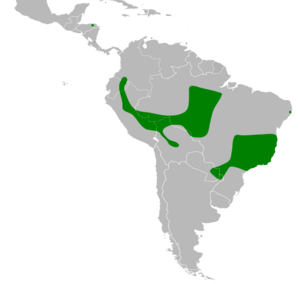Ocellated poorwill facts for kids
Quick facts for kids Ocellated poorwill |
|
|---|---|
 |
|
| at Tremembé, São Paulo State, Brazil | |
| Conservation status | |
| Scientific classification | |
| Genus: |
Nyctiphrynus
|
| Species: |
ocellatus
|
 |
|
The ocellated poorwill (Nyctiphrynus ocellatus) is a cool bird that belongs to the nightjar family, called Caprimulgidae. You can find it in many countries, including Argentina, Bolivia, Brazil, Colombia, Costa Rica, Ecuador, Honduras, Nicaragua, Paraguay, and Peru.
Contents
What is the Ocellated Poorwill?
Scientists group living things to understand them better. The ocellated poorwill is a type of bird. Long ago, another bird called the Choco poorwill was thought to be a part of the ocellated poorwill family. But after looking closely at their feathers, listening to their calls, and studying their genes, scientists realized they were different species.
Today, we know there are two main types, or subspecies, of the ocellated poorwill: N. o. ocellatus and N. o. lautus.
How to Identify an Ocellated Poorwill?
This bird is about 20 to 21 centimeters (8 to 8.3 inches) long. Males usually weigh between 35 and 43 grams (1.2 to 1.5 ounces), while females weigh 29 to 44 grams (1 to 1.6 ounces).
Ocellated poorwills come in two main colors: brown or reddish-brown. The brown ones are mostly dark grayish-brown. They have blackish-brown spots on their wings and white spots on their belly. These white spots look a bit like eyes, which is how the bird got its name, "ocellated" meaning "having small eye-like spots." They also have a bright white band around their throat. The tips of their outer tail feathers are white.
The reddish-brown birds are lighter in color. The N. o. lautus subspecies is a bit smaller, and the white tips on its tail feathers are narrower.
Where Do Ocellated Poorwills Live?
The ocellated poorwill lives in different areas that are not connected. The N. o. ocellatus subspecies is found in two main parts of South America. One area stretches from southern Colombia, through eastern Ecuador and Peru, into Bolivia, and east into the Amazon region of Brazil. The other area is in southeastern Brazil, extending west into eastern Paraguay and the very northeastern part of Argentina.
The N. o. lautus subspecies lives in Central America, specifically near the border of eastern Honduras and northeastern Nicaragua, and in northwestern Costa Rica. There has also been one possible sighting in Panama.
These birds mostly live in lowland forests that have an open area underneath the trees and small clearings. They can also be found in thick secondary forest, which is forest that has grown back after being cut down. You can find them from sea level up to about 1,350 meters (4,430 feet) high.
Ocellated Poorwill Behavior
What Do Ocellated Poorwills Eat?
The ocellated poorwill is a nocturnal bird, meaning it is active at night. It hunts for food by flying out from a low branch to catch insects. Its diet includes many different kinds of insects.
Reproduction and Life Cycle
Scientists are still learning about when ocellated poorwills breed, as it seems to be different depending on where they live. When they lay eggs, they don't build a nest. Instead, they lay two eggs directly on the ground or on a pile of leaves, usually under some kind of cover. Both the male and female birds take turns sitting on the eggs to keep them warm until they hatch.
What Sounds Do Ocellated Poorwills Make?
The male ocellated poorwill has a special song. It's a repeated, trilling sound that sounds like "preeeo" or "prEEoo." Their regular call is a soft, deep sound, like "wah, wah, wah."
Is the Ocellated Poorwill in Danger?
The IUCN (International Union for Conservation of Nature) has looked at the ocellated poorwill and decided it is a species of "Least Concern." This means it is not currently considered to be in danger of disappearing. It lives across a very large area and has a very big population. However, scientists believe its population might be slowly getting smaller. The main thing that could threaten these birds is deforestation, which is when forests are cut down, especially in the Central American areas where they live.


